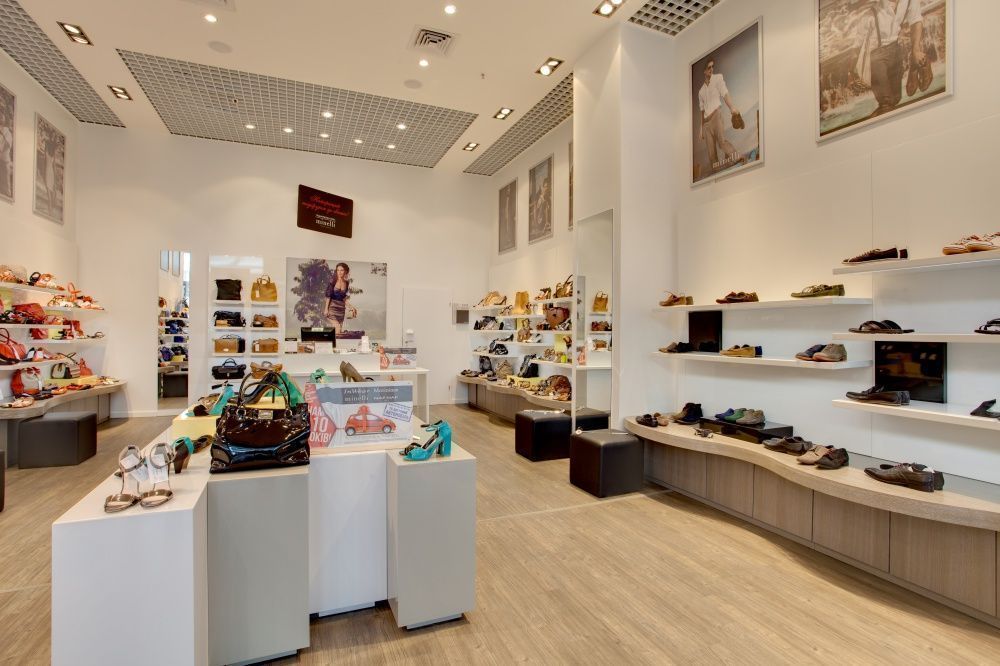
Store Assortment

You can and should manage the assortment in any organization - both in a powerful international network and in a private small store on the outskirts, regardless of the company's product specifics and structure. Regardless of the crisis. An unstructured and unmanaged assortment can plunge a company into crisis in the most favorable economic environment.
 Ekaterina Buzukova - Russia's leading retail assortment management consultant, category management specialist, business coach, seminar host, author and co-author of the books “Assortment Management in Retail. Category Management ”,“ Merchandising ”and“ Procurement and Suppliers ”. www.assorts.ru
Ekaterina Buzukova - Russia's leading retail assortment management consultant, category management specialist, business coach, seminar host, author and co-author of the books “Assortment Management in Retail. Category Management ”,“ Merchandising ”and“ Procurement and Suppliers ”. www.assorts.ru
In one ancient textbook of military art, a definition is given, the essence of which is that strategy is the arrangement of troops before the battle, while tactics is the movement of troops during the battle. This definition seemed quite acceptable, as business more and more resembles a battlefield - with competitors for a large market share, with suppliers for better deal conditions, with new laws, regulations, government bans or permits, with landlords and tenants, and even with buyers - for their attention and wallet.
But at its core, all the activities of the company - assortment and procurement policies, personnel policies, sales methods and distribution channels, marketing policies - these are tactical measures aimed at achieving global strategic goals.
You can and should manage the assortment in any organization - both in a powerful international network and in a private small store on the outskirts, regardless of the company's product specifics and structure. Regardless of the crisis. An unstructured and unmanaged assortment can plunge a company into crisis in the most favorable economic environment.
The strategy is to ensure that management clearly understands the ways and means of achieving quantitative (financial) and qualitative goals. This is precisely the essence of developing a strategy - in what way will we achieve a turnover of, say, in 1 a million rubles a month? What do you need to do for this? Which competitors to consider, what and which buyers to sell, which suppliers to choose as partners?
If we work using a pseudo-strategy of "how it goes", then sooner or later we will be faced with such circumstances that can seriously affect our business. According to statistics, only five percent of the total number of newly created enterprises can be considered successful. About a third of new businesses are closed during their first year of operation. Why? Precisely because the leader did not show due attention to the strategy of the enterprise, letting the situation take its course, and deciding only current affairs. Successfully solving operational problems (negotiate, take out, deliver, install, print, pay, clear customs, hire, fire, etc.), they did not see the main thing - what the consumer demands and the market dictates.
Assortment formation How is assortment usually formed? A supplier’s proposal appears, it is considered by the purchaser and commercial director, it is acceptable and a narrow assortment is imported for testing in small batches. Then, under a successful set of circumstances, the demand for this product begins. After some time, sales begin to demand more and more goods and it is good if the deliveries of goods keep up with demand. And after some time, the assortment of 10 items brought to the sample turns into 100 items, of which 20% is a clear illiquid item, brought back again, “to the sample”.
Who, if not the buyer, knows that the range has a tendency to uncontrolled growth! We do not have time to come to our senses, as we cover our assortment with shells as a ship.
Required to legitimize their relationship with the range. Based on the competitive strategy, the company should have a document defining its assortment policy. The general provision on assortment policy will serve as the basis for further work with the assortment.

Typical difficulties in assortment management
Carrying out assortment policy, the company always faces some tactical difficulties. For example, inadequate qualifications of the personnel in charge of procurement, or a difficult supplier, delay in deliveries, or the consequences of the adoption of the new excise duty law ... There are enough problems that can nevertheless be resolved if there are no strategic mistakes in the assortment policy.
As a rule, such critical points can be:
1. Lack of a coherent and uniform strategy for the development of the company for all employees. Perhaps there is a strategy, but it is in the head of the first person of the company, who does not consider it necessary to share it. Or the strategy is blurred and spelled out according to the principle "We sell everything for everyone and our main task is to earn as much money as possible by any means."
2. Lack of a specific person responsible for assortment development and management. As a rule, there are persons responsible for procurement, for sales, for marketing, for logistics. And the concept of "assortment" remains unreached and is not reflected in the job description of the commercial director. In the practice of successfully operating companies, a commercial director or a person with the function of managing category managers (the head of the sales department, the head of the procurement department, etc.) is responsible for the assortment. This responsibility should be spelled out in the regulation on the formation of the assortment (see above).
3. Lack of service, emphasis only on the product and the physical properties of the assortment (width, depth). Yes, the product and the product itself is good, but the current conditions of competition lead to the fact that the product itself does not have that value. This also becomes part of the range, paradoxically as it sounds. A service is the same product of a store, it is also a product that must be sold.
4. There are no exclusive or unique items or services in the assortment. If there are none, then how do we differ from our competitors? Why should a buyer come to us and not to a nearby store? Uniqueness is a “hook” that makes the buyer come again and again.
5. The assortment has not been updated for a long time (stagnation of the assortment). There are no new goods and services in the near future. Updating the assortment not only satisfies the need to try new things, but also allows you to always maintain the optimal ratio of goods with different duration of the life cycle.
6. High dependence of sales on seasonal fluctuations. If we have sales only in winter (for example, we are the “Skis” store), then what will be sold here in the summer? Two development options - in the spring, close the store and all go on a six-month vacation, rileatherg falling overboard in the autumn of the business. Or reconsider the store’s concept, name it “Skis, Bicycles, Rollers and Skates” and sell a seasonal assortment, but pick up your own product for each season.
7. The assortment is formed by goods from suppliers-monopolists. In this case, we become dependent on their distribution policies and prices. No comments.
8. Lack of clearly formulated and well-known criteria for employees to assess the quality of goods and services provided by the company. In fact, this is the absence of the rules of the game by which we play. What is good and what is bad for the buyer? How do we relate to the amount of marriage, to returns? We consider this acceptable and, if so, to what extent? Work standards should be clearly defined, spelled out and all staff should not only be familiar with them, but also agree.
Assortment Adjustment
In a crisis, you can reduce the presence in the line of fashioned and expensive goods, low-turnover goods, new products and retention products. However, it is not worth completely abandoning new products and retaining products, since the percentage of customers who refuse a store due to a reduction in their usual assortment can reach 15-20%. The share of goods to increase the volume may, on the contrary, increase (the trend is growing towards economical packaging and economical purchases). The share of goods with constant demand should not change. The number of profitable goods may decrease slightly. When introducing new products and profitable goods, there is a danger of stagnation of the assortment. Sooner or later, the crisis will end, and the buyer's needs will return to the previous level and possibly exceed it.
Therefore, the policy of reducing the assortment should be thought out in order to be able to quickly develop categories towards a high segment. People’s need for new products is almost indestructible. After the crisis, it will become especially relevant. Therefore, a willingness to expand the range should be present. As soon as there is a demand trend for new products, respond immediately.
Economy Savings
The experience of the past crisis shows that:
1. There will be a drop in demand for goods not of prime necessity, the buyer will refuse some expensive and status goods. A decrease in population incomes will lead to a situation of consumption of cheaper goods, to a lesser extent.
2. The share of purchases of non-food items will decrease and the demand for services and entertainment will decrease significantly. In the purchasing budget, the share of food products will increase slightly (due to the redistribution of income).
3. Less attention will be paid to the quality of goods and services, more attention will be paid to prices. Only those “anti-crisis” actions that will direct their focus on the final cheapening of goods for the buyer will be effective.
4. Demand in hypermarkets and discounters will hardly change, although there will be a redistribution towards the purchase of cheaper goods. Specialty and boutique-style stores will feel a significant decrease in demand.

What to do:
1. Centralize the processes of purchasing goods and assortment management as much as possible. The situation when the assortment is formed uncontrollably by the store directors at their discretion (“what to see, how it goes”) must be eliminated.
2. Evaluate the possibilities of the format of your network and the development trends of the assortment - in depth or in width? Eliminate network sprawl or multi-format, focus on a single viable format. 3. Focus your efforts on assortment optimization. Remove categories that do not <profitable, do not retain the buyer, low turnover or not supported by credits from the supplier.
4. Reduce non-profitable product lines that are not flow generators. Reduce the introduction of new products to the assortment (however, do not stop this process at all). Reduce the number of products holding the buyer. Conclusion subject to low-cost goods to maintain the image and affect the impulsiveness of the purchase.
5. It is possible to introduce elements of categorical assortment management (a single function of procurement, pricing and sales control) if this system is not yet implemented in the company.
6. Carry out inventories, devote more time to operational accounting, work with complaints and marriage, work to identify illiquid assets. Motivate staff for these events.
7. To negotiate with suppliers on a possible deferral of payments, repayment of loans in installments. Upon reaching these agreements, strictly observe payment schedules (as you know, compliance with obligations gives more bonuses than the immediate benefit of delayed payments).
This article was published in the 125 issue of the print version of the magazine.
| Please rate the article |
Materials on the topic

Specifics of shoe assortment management on marketplaces and growth points

5 shoe models from Russian brands for New Year's Eve

What to consider when expanding the assortment of a shoe store to include clothing

How to correctly apply category management when managing the assortment of shoes for the marketplace

Bertsy: what to look for when choosing a model
Popular
 Coach turned to Big Data analysis and won the interest of a young audience
American handbag brand Coach has planned the success of its Tabby model among a younger audience, Generation Z, by turning to big data analysis, abandoning traditional and analogue tools, such as human intuition or the ability of any executive to sense “which way the wind will blow,” writes B.O.F.
Coach turned to Big Data analysis and won the interest of a young audience
American handbag brand Coach has planned the success of its Tabby model among a younger audience, Generation Z, by turning to big data analysis, abandoning traditional and analogue tools, such as human intuition or the ability of any executive to sense “which way the wind will blow,” writes B.O.F.
 IDOL updates the concept
The IDOL brand, part of the Melon Fashion Group portfolio, opened the first flagship in an updated concept in the Aviapark shopping center in Moscow.
IDOL updates the concept
The IDOL brand, part of the Melon Fashion Group portfolio, opened the first flagship in an updated concept in the Aviapark shopping center in Moscow.
 Current techniques in lighting a shoe store
Today, walking through the galleries of shopping centers, we see a variety of formats of offline stores. New concepts of retail spaces attract with an individual, memorable design. In a certain sense, they are an element of the show, a tool through which the buyer receives a new and interesting experience. Together with SR expert in the field of lighting technology in retail, Tatyana Ryzhova, we will look at current lighting design techniques for modern shoe stores, which we will see more and more often in new retail outlets in the near future.
Current techniques in lighting a shoe store
Today, walking through the galleries of shopping centers, we see a variety of formats of offline stores. New concepts of retail spaces attract with an individual, memorable design. In a certain sense, they are an element of the show, a tool through which the buyer receives a new and interesting experience. Together with SR expert in the field of lighting technology in retail, Tatyana Ryzhova, we will look at current lighting design techniques for modern shoe stores, which we will see more and more often in new retail outlets in the near future.
 Seven “sins” of the shoe business. How do owners harm the company with their own hands?
Why is Company X able to create a strong, profitable brand, but Company Y is struggling to make ends meet? Many people prefer to attribute success to luck, luck, or the support of strong patrons. And few people ask themselves the question: “What am I doing wrong?” Moreover, many entrepreneurs begin to harm their business from the first day of its opening. In this article, together with SR expert in the field of fashion business management and development, Maria Gerasimenko, we will look at the 7 main “sins” that business owners commit using specific examples.
Seven “sins” of the shoe business. How do owners harm the company with their own hands?
Why is Company X able to create a strong, profitable brand, but Company Y is struggling to make ends meet? Many people prefer to attribute success to luck, luck, or the support of strong patrons. And few people ask themselves the question: “What am I doing wrong?” Moreover, many entrepreneurs begin to harm their business from the first day of its opening. In this article, together with SR expert in the field of fashion business management and development, Maria Gerasimenko, we will look at the 7 main “sins” that business owners commit using specific examples.
 Louis Vuitton opens a new factory in Italy
Louis Vuitton has opened its second shoe factory in Italy. After opening the first one in Fiesso d'Artico in Veneto, the LVMH flagship brand has just opened a new production site dedicated to this category of footwear in the industrial zone of Civitano in the Marche region. There is also another brand production facility in Tuscany, where bags and leather accessories are produced, writes fr.fashionnetwork.com.
Louis Vuitton opens a new factory in Italy
Louis Vuitton has opened its second shoe factory in Italy. After opening the first one in Fiesso d'Artico in Veneto, the LVMH flagship brand has just opened a new production site dedicated to this category of footwear in the industrial zone of Civitano in the Marche region. There is also another brand production facility in Tuscany, where bags and leather accessories are produced, writes fr.fashionnetwork.com.
 The Euro Shoes@CAF exhibition will be held in Almaty
From March 11 to 13, the Euro Shoes@CAF (Central Asia Fashion) exhibition will be held in Almaty at the Atakent exhibition complex. The exhibition, which is the largest international event in the fashion industry in Central Asia, will present collections of clothing, shoes and accessories.
The Euro Shoes@CAF exhibition will be held in Almaty
From March 11 to 13, the Euro Shoes@CAF (Central Asia Fashion) exhibition will be held in Almaty at the Atakent exhibition complex. The exhibition, which is the largest international event in the fashion industry in Central Asia, will present collections of clothing, shoes and accessories.
 Euro Shoes will start operating on February 19 in Moscow!
The winter session of the international exhibition of footwear and accessories Euro Shoes premiere collection will be held in Moscow at the Expocenter from February 19 to 22. The organizers promise the presence of all the main participants at the exhibition, as well as new names from Europe, Asia and Russia.
Euro Shoes will start operating on February 19 in Moscow!
The winter session of the international exhibition of footwear and accessories Euro Shoes premiere collection will be held in Moscow at the Expocenter from February 19 to 22. The organizers promise the presence of all the main participants at the exhibition, as well as new names from Europe, Asia and Russia.
 American buyers couldn't buy Birkin bags and sued Hermès
French fashion house Hermès is facing a lawsuit in California from two customers who were unable to purchase exclusive Birkin bags. The fashion house is accused of unfair commercial practices.
American buyers couldn't buy Birkin bags and sued Hermès
French fashion house Hermès is facing a lawsuit in California from two customers who were unable to purchase exclusive Birkin bags. The fashion house is accused of unfair commercial practices.
 Why Rendez-Vous and Yandex Lavka released a “bread bag”
Shoe retailer Rendez-Vous announced the launch of a spring collaboration with Yandex Lavka and released a roll that resembles the shape of a woman’s handbag. This “Bread Bag” is presented in the Yandex.Lavka application at a price of 249 rubles. On the product packaging there is a promotional code for 1000 rubles, which can be spent in the Rendez-Vous network.
Why Rendez-Vous and Yandex Lavka released a “bread bag”
Shoe retailer Rendez-Vous announced the launch of a spring collaboration with Yandex Lavka and released a roll that resembles the shape of a woman’s handbag. This “Bread Bag” is presented in the Yandex.Lavka application at a price of 249 rubles. On the product packaging there is a promotional code for 1000 rubles, which can be spent in the Rendez-Vous network.
 Camper has released innovative sneakers - designers
Spanish brand Camper's new Roku sneaker features six interchangeable components to create up to 64 different looks and color combinations. Roku means "six" in Japanese.
Camper has released innovative sneakers - designers
Spanish brand Camper's new Roku sneaker features six interchangeable components to create up to 64 different looks and color combinations. Roku means "six" in Japanese.
 Christian Louboutin presented a collection in a cowboy style
At the Loubi Show in Paris, the French luxury brand Christian Louboutin presented its fall 2024 collection, following the trend - in the style of the Wild West. It included cowboy boots and rhinestone loafers.
Christian Louboutin presented a collection in a cowboy style
At the Loubi Show in Paris, the French luxury brand Christian Louboutin presented its fall 2024 collection, following the trend - in the style of the Wild West. It included cowboy boots and rhinestone loafers.
 Turkish brand Vaneda on Euro Shoes
Street style, sport, outdoor, military – the main style directions of footwear of the company from Turkey
Turkish brand Vaneda on Euro Shoes
Street style, sport, outdoor, military – the main style directions of footwear of the company from Turkey
 Fashion Week takes place in Moscow
Fashion Week takes place in the Russian capital. Events include fashion shows, markets where you can purchase clothes, bags and accessories, and a B2B Showroom for fashion industry professionals.
Fashion Week takes place in Moscow
Fashion Week takes place in the Russian capital. Events include fashion shows, markets where you can purchase clothes, bags and accessories, and a B2B Showroom for fashion industry professionals.
 We are ready for active development in the Russian market
Friedrich Naumann, CEO of the Tamaris brand, told Shoes Report about the company’s ambitious plans, business development in Russia and expansion of the retail network, and also shared details about new collections and launches.
We are ready for active development in the Russian market
Friedrich Naumann, CEO of the Tamaris brand, told Shoes Report about the company’s ambitious plans, business development in Russia and expansion of the retail network, and also shared details about new collections and launches.
 Fashion trends Fall-Winter 2023/24 for commercial footwear purchases
Permanent contributor to Shoes Report. Elena Vinogradova, an expert in sales and purchases in the fashion business, prepared an overview of the trends for the autumn-winter 2023/24 season especially for us.
Fashion trends Fall-Winter 2023/24 for commercial footwear purchases
Permanent contributor to Shoes Report. Elena Vinogradova, an expert in sales and purchases in the fashion business, prepared an overview of the trends for the autumn-winter 2023/24 season especially for us.
 MSCHF and Crocs launch "Big Yellow Boots"
Creator of the Big Red Boots, Brooklyn brand MSCHF has teamed up with American plastic clog and sandal brand Crocs for another oversized shoe. The new Big Yellow Boots will go on sale on August 9th.
MSCHF and Crocs launch "Big Yellow Boots"
Creator of the Big Red Boots, Brooklyn brand MSCHF has teamed up with American plastic clog and sandal brand Crocs for another oversized shoe. The new Big Yellow Boots will go on sale on August 9th.
 Five rules of professional lighting for a shoe store - something that is relevant in any season
When developing a lighting concept for shoe retailers, it is important to take into account not only the history of the brand, the architectural content of the premises, the target audience of the stores, but also the seasonality of the goods. With the onset of the cold season, client preferences change: bright weightless shoes are replaced by more massive models in discreet dark colors. Despite significant differences in summer and winter collections, the overall philosophy of the brand, its recognition should remain unchanged at any time of the year. Tatyana Ryzhova, an SR lighting expert in fashion retail, has identified five basic rules for a competent lighting concept for a shoe store for readers of the magazine, which will help to present winter assortment to customers in a winning way.
Five rules of professional lighting for a shoe store - something that is relevant in any season
When developing a lighting concept for shoe retailers, it is important to take into account not only the history of the brand, the architectural content of the premises, the target audience of the stores, but also the seasonality of the goods. With the onset of the cold season, client preferences change: bright weightless shoes are replaced by more massive models in discreet dark colors. Despite significant differences in summer and winter collections, the overall philosophy of the brand, its recognition should remain unchanged at any time of the year. Tatyana Ryzhova, an SR lighting expert in fashion retail, has identified five basic rules for a competent lighting concept for a shoe store for readers of the magazine, which will help to present winter assortment to customers in a winning way.
 I doubt and object: how to find an approach to difficult clients?
How good and serene would be the work of a salesperson if the customers were calm, cheerful, always knew exactly what they wanted, and bought, bought, bought! It is a pity that this is possible only in dreams. Therefore, we will not dream, but we will act. Together with Maria Gerasimenko, a permanent author of SR, we understand the doubts and objections of buyers and build a strategy for working with them. Our expert pays special attention to the two main objections of buyers, on which 82% of sales are lost.
I doubt and object: how to find an approach to difficult clients?
How good and serene would be the work of a salesperson if the customers were calm, cheerful, always knew exactly what they wanted, and bought, bought, bought! It is a pity that this is possible only in dreams. Therefore, we will not dream, but we will act. Together with Maria Gerasimenko, a permanent author of SR, we understand the doubts and objections of buyers and build a strategy for working with them. Our expert pays special attention to the two main objections of buyers, on which 82% of sales are lost.
 EURO SHOES presents an updated section of the GLOBAL SHOES exhibition with collections of shoe and bag brands from Asian countries
EURO SHOES premiere collection is expanding. Along with the traditional pool of leading European footwear brands from Germany, Spain, Italy and Turkey, several dozen footwear and bag brands from the Middle Kingdom will be presented in the GLOBAL SHOES section at the Moscow Expocentre from August 29 to September 1.
EURO SHOES presents an updated section of the GLOBAL SHOES exhibition with collections of shoe and bag brands from Asian countries
EURO SHOES premiere collection is expanding. Along with the traditional pool of leading European footwear brands from Germany, Spain, Italy and Turkey, several dozen footwear and bag brands from the Middle Kingdom will be presented in the GLOBAL SHOES section at the Moscow Expocentre from August 29 to September 1.
 World Footwear Yearbook: Global footwear production reaches 23,9 billion pairs and is back to pre-pandemic levels
The Portuguese association of shoe manufacturers APICCAPS published the 13th edition of the international statistical bulletin World Footwear Yearbook for 2023, according to which in 2022 the production and export of shoes worldwide increased by 7,6% and 9%, respectively, and the world production of shoes reached 23,9 billion couples and returned to pre-pandemic levels.
World Footwear Yearbook: Global footwear production reaches 23,9 billion pairs and is back to pre-pandemic levels
The Portuguese association of shoe manufacturers APICCAPS published the 13th edition of the international statistical bulletin World Footwear Yearbook for 2023, according to which in 2022 the production and export of shoes worldwide increased by 7,6% and 9%, respectively, and the world production of shoes reached 23,9 billion couples and returned to pre-pandemic levels.
 Rostov footwear brand Novak presented a collection of sneakers and sneakers
In the spring-summer 2023 season, the Rostov-on-Don shoe brand Novak presented a cute collection of sneakers and sneakers for every day. The upper of the shoe is made of genuine leather, suede, nubuck, the sole is made of light EVA.
Rostov footwear brand Novak presented a collection of sneakers and sneakers
In the spring-summer 2023 season, the Rostov-on-Don shoe brand Novak presented a cute collection of sneakers and sneakers for every day. The upper of the shoe is made of genuine leather, suede, nubuck, the sole is made of light EVA.
 Jacquemus x Nike collaboration released
The second collaboration between Jacquemus and Nike, which has been talked about so much, is finally out. The appearance of the couple for many was a surprise. The model of Nike Air Force 1 sneakers, which was taken as the basis of the new collection, has undergone significant changes.
Jacquemus x Nike collaboration released
The second collaboration between Jacquemus and Nike, which has been talked about so much, is finally out. The appearance of the couple for many was a surprise. The model of Nike Air Force 1 sneakers, which was taken as the basis of the new collection, has undergone significant changes.
 Crocs releases a collaboration with Barbie
If Barbie ditched heels and wore crocs, they would be pink. It was this collection in pink that was released by the American brand of plastic clogs Crocs, for the release of the film "Barbie" in the United States.
Crocs releases a collaboration with Barbie
If Barbie ditched heels and wore crocs, they would be pink. It was this collection in pink that was released by the American brand of plastic clogs Crocs, for the release of the film "Barbie" in the United States.
 Japanese BAPE takes to the catwalk MSCHF Big Red Boots
The story of Brooklyn brand MSCHF's oversized rubber boots continues. The last time they made noise in the auditorium was at the Rick Owens menswear show. Now they have already appeared on the podium.
Japanese BAPE takes to the catwalk MSCHF Big Red Boots
The story of Brooklyn brand MSCHF's oversized rubber boots continues. The last time they made noise in the auditorium was at the Rick Owens menswear show. Now they have already appeared on the podium.
 Shoe educational program: what shoe soles are made of
“What is the difference between TEP and EVA? What does tunit promise me? Is PVC glue? What is the sole of these shoes made of? ”- the modern buyer wants to know everything. In order not to smash his face in front of him and be able to explain whether such a sole suits him in soles, carefully read this article. In it, process engineer Igor Okorokov tells what materials the soles of shoes are made of and what makes each of them so good.
Shoe educational program: what shoe soles are made of
“What is the difference between TEP and EVA? What does tunit promise me? Is PVC glue? What is the sole of these shoes made of? ”- the modern buyer wants to know everything. In order not to smash his face in front of him and be able to explain whether such a sole suits him in soles, carefully read this article. In it, process engineer Igor Okorokov tells what materials the soles of shoes are made of and what makes each of them so good.
 How to set prices that will earn
Some businessmen still confuse the concept of margin with the concept of trade margins and set prices for their goods, guided solely by the example of competitors. No wonder they go broke! Analyst at the Academy of Retail Technologies Maxim Gorshkov gives several tips and formulas with which you can set not only ruinous, but also profitable prices.
How to set prices that will earn
Some businessmen still confuse the concept of margin with the concept of trade margins and set prices for their goods, guided solely by the example of competitors. No wonder they go broke! Analyst at the Academy of Retail Technologies Maxim Gorshkov gives several tips and formulas with which you can set not only ruinous, but also profitable prices.
 Sales of shoes and accessories: effective techniques for business rhetoric
Which speech modules are effective in communicating with potential and current customers of shoe stores, and which are not, Anna Bocharova, a business consultant, knows.
Sales of shoes and accessories: effective techniques for business rhetoric
Which speech modules are effective in communicating with potential and current customers of shoe stores, and which are not, Anna Bocharova, a business consultant, knows.
 We form the salary of sellers: expert advice
“How do you charge your consultants for personal or general sales?” Is one of the most popular questions causing a lot of controversy and gossip on the online forums of retail business owners. Indeed, how to properly form the earnings of sellers? But what about bonuses, where to get a sales plan from, do employees allow them to buy goods at discounted stores? In search of truth, the Shoes Report turned to a dozen shoe retailers, but no company wanted to disclose its motivation system - the process of its development was too complicated and individual. Then we asked four business consultants, and finally became convinced that the topic of seller motivation is very complex, because even our experts could not come to a common opinion.
We form the salary of sellers: expert advice
“How do you charge your consultants for personal or general sales?” Is one of the most popular questions causing a lot of controversy and gossip on the online forums of retail business owners. Indeed, how to properly form the earnings of sellers? But what about bonuses, where to get a sales plan from, do employees allow them to buy goods at discounted stores? In search of truth, the Shoes Report turned to a dozen shoe retailers, but no company wanted to disclose its motivation system - the process of its development was too complicated and individual. Then we asked four business consultants, and finally became convinced that the topic of seller motivation is very complex, because even our experts could not come to a common opinion.
 Technology Selling Issues
There is nothing worse than meeting the buyer with the words “Hello, can I help you with something?”, Because the seller works in the store just to help. Criticizing this well-established pattern of communication with the buyer, Andrei Chirkarev, business coach for effective sales and the founder of the New Economy project, shares the technology of truly selling issues with readers of Shoes Report.
Technology Selling Issues
There is nothing worse than meeting the buyer with the words “Hello, can I help you with something?”, Because the seller works in the store just to help. Criticizing this well-established pattern of communication with the buyer, Andrei Chirkarev, business coach for effective sales and the founder of the New Economy project, shares the technology of truly selling issues with readers of Shoes Report.
 The whole truth about Bayer. Who is he and how to become one?
Bayer is no longer a new, but still a popular and sought-after profession. It’s fashionable to be a buyer. Buyers are at the origins of the emergence and development of trends. If the designer offers his vision of fashion in the season, then the buyer selects the most interesting commercial ideas. It is on buyers that the policy of sales of stores and what, in the end, the buyer will wear depends on. This profession is surrounded by a magical fleur, often associated with a lack of understanding of what exactly is the work of a buyer.
The whole truth about Bayer. Who is he and how to become one?
Bayer is no longer a new, but still a popular and sought-after profession. It’s fashionable to be a buyer. Buyers are at the origins of the emergence and development of trends. If the designer offers his vision of fashion in the season, then the buyer selects the most interesting commercial ideas. It is on buyers that the policy of sales of stores and what, in the end, the buyer will wear depends on. This profession is surrounded by a magical fleur, often associated with a lack of understanding of what exactly is the work of a buyer.
 Fur, and not only: types of lining
In the production of winter footwear, various materials are used that are designed to retain heat and meet the requirements of consumers: natural sheepleather, artificial fur, artificial fur from natural wool and others. All types of lining fur have their own advantages and disadvantages. Let's consider the properties of each of them.
Fur, and not only: types of lining
In the production of winter footwear, various materials are used that are designed to retain heat and meet the requirements of consumers: natural sheepleather, artificial fur, artificial fur from natural wool and others. All types of lining fur have their own advantages and disadvantages. Let's consider the properties of each of them.
 Retail Arithmetic
Before you begin to solve specific problems, you need to find out how accurately all the leaders of your company understand the basic terminology of retail.
Retail Arithmetic
Before you begin to solve specific problems, you need to find out how accurately all the leaders of your company understand the basic terminology of retail.
 How to fire a worker without tears, scandal and trial
Sooner or later, any manager is faced with the need to part with an employee. Properly and on time the dismissal procedure will save the company money, and the boss himself - nerves and time. But why sometimes, knowing that a break in relations is inevitable, we put off the decision for months?
How to fire a worker without tears, scandal and trial
Sooner or later, any manager is faced with the need to part with an employee. Properly and on time the dismissal procedure will save the company money, and the boss himself - nerves and time. But why sometimes, knowing that a break in relations is inevitable, we put off the decision for months?






